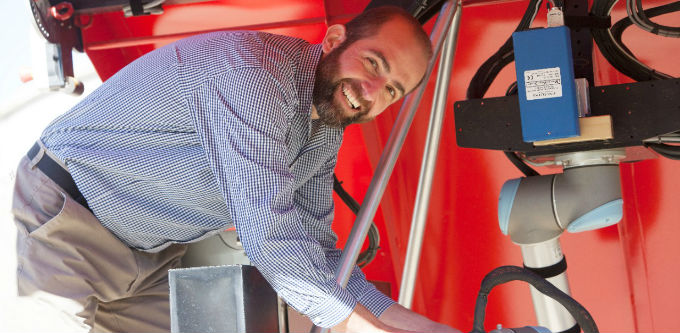
Agerris founder and chief executive Salah Sukkarieh. Source: Supplied.
Field robotics startup Agerris has launched onto the agtech scene, securing $6.5 million in seed funding to commercialise its automated farm equipment and help support farmers all over Australia.
The funding comes from research commercialisation fund Uniseed and VC firms Carthona Capital and BridgeLane Group, and coincides with the startup officially incorporating as a business.
Born out of University of Sydney research, Agerris develops robotic systems featuring AI and decision mapping, to lend farmers a hand with anything from weeding and spraying to harvesting and picking fruit.
Speaking to StartupSmart, founder and chief executive Professor Salah Sukkarieh explained he’s been working on outdoor robotic systems and machine learning and automation for some 15 years, although largely in a research-and-development context.
“It’s very hard to find robust 24-7 systems that can operate on a farm in all weather,” he says.
Now, after combining the robust hardware with AI and machine learning technology, he has a product that can bring real value to the Australian agriculture ecosystem, he says.
“It was important to take it out of the lab and give it to the farmers,” he adds.
He may be a university professor, but Sukkarieh’s background is not one of a “classic academic”.
Previously, he has worked in “translational research”, helping large corporates and smaller industry players incorporate new technologies and techniques into their processes.
“I’ve always dabbled in that border between prototype and operation,” he says.
Faced with the opportunity to commercialise the Agerris research, “I felt I was in the best position to translate that”.
A perfect storm
Agricultural technology is something of a hot topic in Australia at the moment, with new startups cropping up and existing ones raising funds seemingly constantly.
In 2019 so far, livestock food supplement startup Direct Injection Technologies raised $656,500 in its crowdfunding campaign, agricultural data startup FluroSat secured $3 million in grant funding, and Western Australia’s AgriStart CONNECT program secured $500,000 in grant funding to support regional agtech startups.
According to Sukkarieh, the pickup of activity in this space has been driven by a perfect storm of factors.
First, it’s driven by “how hard farmers are finding it”, he says. Extreme weather events and a lack of labour mean many farmers are more stretched than ever, he says.
Second, a growing population and more international competition mean there’s greater demand for improving productivity and efficiency.
Finally, quickly advancing technology, particularly around AI and processing, mean we have “the ability to piece those together”, Sukkarieh says.
For the past 10 years, the researcher-turned-founder has been working on farms and with farmers.
He secured “funding from industry to work with industry”, including from Meat and Livestock Australia, and has focused on trialling the bots “in an operational setting”, he says.
“It hasn’t been a lab exercise,” he adds.
Now, the funding will be used to grow Agerris from a “high prototype level into high-scale operation”.
The plan is to hone “reliable platforms farmers will use” and to “understand the value-add the bots will give”, he adds.
Sukkarieh plans to hire about 13 people, mainly to work on tech development, but also in sales and marketing roles.
The startup will trial and develop the systems in Australia, before starting to think about international expansion. But it’s early days yet.
Within the next 12 months, “I’m hoping to have a few bots out there on farms, working with farmers”, the founder says.
“And it would be great if there were some sales.”
“Stick to the vision”
For other aspiring founders considering taking their research commercial, Sukkarieh’s advice is first and foremost to “stick to the vision”, he says.
“Researchers are generally passionate about some piece of tech that they like,” he explains.
As the product develops, sticking to that original passion is important.
At the same time, “you’ve got to be able to learn to adapt and change”.
While researchers are interested in advancing technology and being as innovative as possible, they must also remember to listen to the end-users, Sukkarieh explains.
A “classic startup” may identify a gap in the market and set about creating a product to fill it.
Research startups begin with the technology, and sometimes can find their solution “doesn’t quite fit”, Sukkarieh warns.
“Speak to the end-user and get feedback,” he says.


COMMENTS
SmartCompany is committed to hosting lively discussions. Help us keep the conversation useful, interesting and welcoming. We aim to publish comments quickly in the interest of promoting robust conversation, but we’re a small team and we deploy filters to protect against legal risk. Occasionally your comment may be held up while it is being reviewed, but we’re working as fast as we can to keep the conversation rolling.
The SmartCompany comment section is members-only content. Please subscribe to leave a comment.
The SmartCompany comment section is members-only content. Please login to leave a comment.